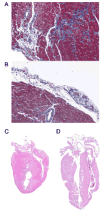Coxsackievirus-induced myocarditis in mice: a model of autoimmune disease for studying immunotoxicity
- PMID: 17161308
- PMCID: PMC1764911
- DOI: 10.1016/j.ymeth.2006.07.009
Coxsackievirus-induced myocarditis in mice: a model of autoimmune disease for studying immunotoxicity
Abstract
Excellent animal models are available for virus-induced and autoimmune heart disease that are remarkably similar to human disease. Developing good animal models for heart disease is crucial because cardiovascular disease is now the leading cause of death in the United States and is estimated to be the leading cause of death in the world by the year 2020. A significant proportion of heart disease in Western populations is associated with inflammation. Myocarditis, or inflammation of the heart muscle, is the major cause of sudden death in young adults. Although most individuals recover from acute myocarditis, genetically susceptible individuals may go on to develop chronic myocarditis and dilated cardiomyopathy (DCM) resulting in congestive heart failure. In this article, we describe a model of autoimmune myocarditis and DCM induced by inoculation with heart-passaged coxsackievirus B3 (CVB3). Intraperitoneal inoculation of susceptible mice with CVB3 induces acute cardiac inflammation from days 7 to 14 postinfection (pi) that progresses to chronic myocarditis and DCM from day 28 to at least 56 pi. The model of CVB3-induced myocarditis presented here allows dissection of the contribution of viral infection and xenobiotics on immune dysregulation and inflammation in the heart. An improved understanding of the interaction between environmental exposures and the development of heart disease represents a clear challenge for immunotoxicologists.
Figures



References
-
- American Heart Association. Heart Disease & Stroke Statistics- 2005 Update (2005) www.americanheart.org.
-
- Willerson JT, Ridker PM. Circulation. 2004;109(suppl II):II2–II10. - PubMed
-
- Dec GW. In: Myocarditis: From Bench to Bedside. Cooper LT Jr, editor. Humana Press; Totowa, New Jersey: 2003. pp. 157–281.
-
- Yusuf S, Reddy S, Ounpuu S, Anand S. Circulation. 2001;104:2746–2753. - PubMed
-
- Rose NR, Wolfgram LJ, Herkowitz A, Beisel KW. Ann NY Acad Sci. 1986;475:146–156. - PubMed
Publication types
MeSH terms
Substances
Grants and funding
LinkOut - more resources
Full Text Sources
Other Literature Sources
Research Materials
Miscellaneous

